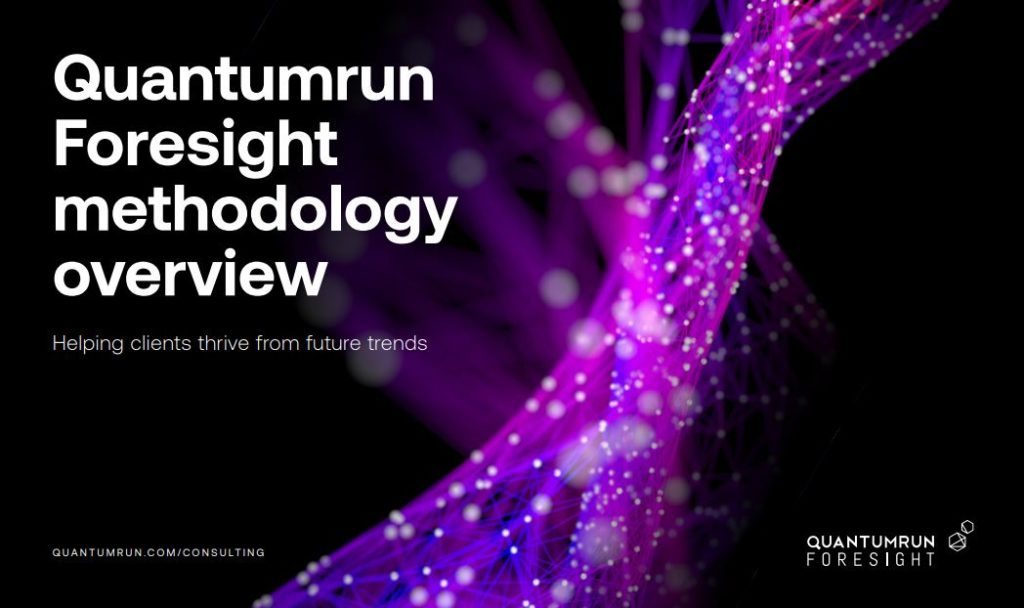Quantumrun Methodology
What is strategic foresight?
Strategic foresight is a discipline that empowers individuals and organizations with improved preparedness for the different futures they may experience in the near and distant future.
This discipline enables practitioners to identify the driving forces of change and disruption that will influence future events in a way that systematically reveals the possible, plausible, and probable futures that lie ahead but with the ultimate goal of selecting one preferred future to pursue strategically. The graph below illustrates the different futures that strategic foresight professionals attempt to explore.


Near-term reasons to use foresight


Production ideation
Collect inspiration from future trends to design new products, services, policies, and business models your organization can invest in today.


Strategic planning & policy development
Identify future solutions to complex present-day challenges. Use these insights to implement inventive policies and action plans in the present day.


Cross-industry market intelligence
Collect market intelligence about emerging trends happening in industries outside your team's area of expertise that may directly or indirectly impact your organization's operations.
Early warning systems
Establish early warning systems to prepare for market disruptions.


Scenario building
Explore future (five, 10, 20 years+) business scenarios that your organization may operate in and identify actionable strategies for success in these future environments.
Tech and startup scouting
Research the technologies and startups/partners necessary to build and launch a future business idea or a future expansion vision for a target market.


Funding prioritization
Use scenario-building exercises to identify research priorities, plan science and technology funding, and plan large public expenditures that could have long-term consequences (e.g., infrastructure).
The Quantumrun Foresight approach
Our international team of analysts monitors and reviews journals and research reports from a wide range of industries. We regularly interview and survey our large network of subject matter experts to gather on-the-ground observations from their particular fields. After integrating and assessing these insights inside the Quantumrun Foresight Platform, we then make informed forecasts about future trends and scenarios that are both comprehensive and multidisciplinary.
The result of our research assists organizations in the development of new or improved products, services, policies, and business models, as well as assisting organizations in deciding what investments to make or avoid in the near-to-distant future.
To illustrate our approach, the following process is the default methodology that the Quantumrun Foresight team applies to any foresight project:
| Step | Description | Product | Step Lead |
|---|---|---|---|
| Step Framing | Description Scope the project: Purpose, objectives, stakeholders, timelines, budget, deliverables; assessing current state vs preferred future state. | Product Project plan | Step Lead Quantumrun + client |
| Step Scanning | Description Collect information: Assess data collection strategy, isolate data collection mediums and sources, then collect relevant historical, contextual, and predictive data that applies directly and indirectly to the foresight project. This stage may be influenced by the scenario-building process. This stage is also facilitated by the Quantumrun Foresight Platform. | Product Information | Step Lead Quantumrun |
| Step Trend Synthesis | Description By analyzing the insights identified from the scenario modeling and trend scanning steps, we proceed to look for patterns—the goal being to isolate and rank drivers (macro and micro) and trends by importance and uncertainty—that can guide the rest of the project. This stage is facilitated by the Quantumrun Foresight Platform. | Product Clustered information | Step Lead Quantumrun |
| Step Constraints | Description Understand the constraints all future scenarios and research must operate in, such as: budgets, timelines, legislation, environment, culture, stakeholders, human resources, organization, geopolitics, etc. The goal is to narrow the project's focus to those scenarios, trends, and insights that can offer clients the most value. | Product Scenario refinement | Step Lead Quantumrun |
| Step Scenario building | Description (Optional) For organizations interested in exploring new products, services, policy ideas, or business models that require multi-year planning and investments, Quantumrun encourages a process called scenario modeling. This method involves in-depth analysis and exploration of different market environments that may emerge over the coming five, 10, 20 years or longer. Understanding these future scenarios can provide organizations with greater confidence when planning strategic long-term investments. This stage is facilitated by the Quantumrun Foresight Platform. | Product Baseline and alternative futures (scenarios) | Step Lead Quantumrun |
| Step Option generation | Description Carefully evaluate the research to identify future opportunities and potential threats the organization may face, and prioritize potential strategy options that require further analysis and development. | Product Identify opportunities | Step Lead Quantumrun |
| Step Ideation | Description Choose a preferred future: Prioritize the opportunities to pursue and threats to avoid. Identify potential products, services, policy ideas, and business models to invest in. This stage is also facilitated by the Quantumrun Foresight Platform. | Product Product ideas | Step Lead Quantumrun + client |
| Step Management consulting | Description For the product or strategy being pursued: Research its potential market viability, market size, competitors, strategic partners or acquisition targets, technologies to buy or develop, etc. | Product Market research | Step Lead Quantumrun + client |
| Step Acting | Description Implement the plan: Develop action agendas, institutionalize strategic thinking and intelligence systems, assign projects and deliverables, and communicate the results, etc. | Product Action plan (initiatives) | Step Lead Action plan (initiatives) |
Download Quantumrun Foresight's methodology
Click below to review our firm’s consulting methodology framework and service overview.




